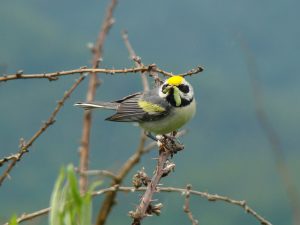Landowners Support Songbird Conservation

A golden-winged warbler eats a caterpillar. Photo by Ed Burress
Cerulean warbler. Photo courtesy of Mdf, Wikimedia Creative Commons
By Kimber Ray
The prevailing chorus of Appalachia’s spring, once dominated by the trills of tiny warblers migrating from Central and South America, has grown increasingly muted over the past century. Efforts to rejuvenate this song are receiving support from two separate, federally funded projects to restore wildlife habitat on private lands, which host nearly two-thirds of all threatened and endangered species in the country.
Since 2012, the U.S. Department of Agriculture and the U.S. Fish and Wildlife Service have partnered with farmers, ranchers and forest landowners on the Working Lands for Wildlife initiative, a five-year project targeting seven at-risk species.
One selected species, the golden-winged warbler, once thrived in the Appalachian mountains from Georgia to New York. The choice nesting ground for this songbird — areas of young trees and shrubland along the edge of dense forests — has declined due to activities such as development and fire suppression. With the assistance of federal funding, landowners commission foresters and wildlife experts from either the state or other local groups to help implement habitat protection strategies, which include limited timber harvesting and selective burning to thin canopy covers, removal of invasive shrubs, and the planting of native species, many of which also benefit pollinators.
The creation of forest-edge habitat in the 7,000 acres currently enrolled in the golden-winged warbler program is already supporting greater populations of the warbler and other shrub-dependent birds, according to a federally funded 2014 assessment. For three years, a team of academic, nonprofit and government researchers tracked more than 800 warblers on 95 properties managed through the program.
It used to be more difficult to evaluate the success of federal wildlife conservation efforts, according to Todd Fearer, coordinator of a regional bird conservation partnership known as Appalachian Mountain Joint Ventures. Now, however, “These practices are specific enough that we can look at how the land was before and after the habitat was implemented, and how the birds respond,” says Fearer.
The partnership has since launched a similar effort in Appalachia, the Cerulean Warbler Appalachian Forestland Enhancement project, which was among 115 conservation programs selected to receive federal funding this past January. The tiny blue-and-white songbirds nest in valuable hardwoods such as oak and hickory, which landowners could be prohibited from harvesting if the cerulean warbler is listed as endangered.
The five-year goal of the project is to enroll 12,500 acres of private forestland in Kentucky, Pennsylvania, Maryland, Ohio and West Virginia. Landowners receive a subsidy to remove lower-quality trees, such as red maple, which in turn creates the open canopy preferred by the cerulean warbler and provides growth space for the more valuable hardwood saplings. This type of habitat also benefits populations of game species such as ruffed grouse, rabbit, deer and turkey.
Additional habitat will be supported by reforesting reclaimed mineland property. More than 1,000 acres of this currently unsuitable habitat will be planted with blight-resistant American chestnut saplings, which may ultimately provide a significant source of habitat and food.
Related Articles
Latest News
More Stories

Leave a comment
Your email address will not be published. Required fields are marked *





Leave a Comment